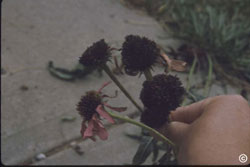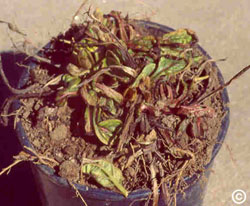
Aster yellows is a severe systemic plant disease that affects many flowers, vegetables and weeds. It is caused by a bacterial-like organism and is carried by the aster leafhopper. Leafhoppers migrate annually to Colorado from overwintering areas along the Gulf of Mexico. Once these insects acquire the disease organism, they carry and spread it for their entire life.
 Aster yellows affects 300 species of plants including coneflower, aster, marigold, zinnia, petunia, lettuce, carrots, beets, onions, dandelions and plantain. The first symptom of the disease is the loss of green pigment in the leaf veins. Damaged plants usually show yellowed, bronzed and twisted or stunted new shoots or flower growth. Seeds and fruit do not develop. In warmer weather symptoms appear more quickly and are more severe..
Aster yellows affects 300 species of plants including coneflower, aster, marigold, zinnia, petunia, lettuce, carrots, beets, onions, dandelions and plantain. The first symptom of the disease is the loss of green pigment in the leaf veins. Damaged plants usually show yellowed, bronzed and twisted or stunted new shoots or flower growth. Seeds and fruit do not develop. In warmer weather symptoms appear more quickly and are more severe..

Controlling aster yellows is difficult. As long as leafhoppers abound, the disease can be carried to plants. The most practical remedy for repeated disease occurrences over several seasons may be to grow less susceptible flowers.
Infected plants and weeds should be promptly removed to minimize the spread of the disease. Management of the insect vector is not usually feasible in a home garden.



